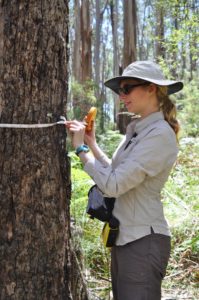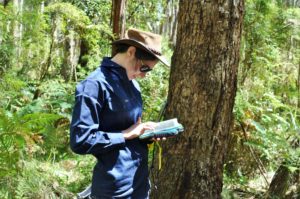Understanding koalas, stress and habitat declines
Founded by the Zeno Karl Schindler Foundation and supported by the University of Queensland, a very important scientific project is underway at the Conservation Ecology Centre.
 As koala habitat continues to decline we are continuing to work towards a a better understanding of the situation in order to contribute to future management.
As koala habitat continues to decline we are continuing to work towards a a better understanding of the situation in order to contribute to future management.
Supervised by Professor Clive McAlpine and the research team at the CEC, Dr Manuelle Cottin and Research Assistant Nicole Davies will be collecting data during the next month, both at CEC and across the neighbouring woodlands, both on private land and through the Great Otway National Park. By collecting data on the condition of koalas and of their trees, researchers will be able to gain more knowledge on the diet and the stress levels of koalas in different habitats.
 More news about the results of this study soon!
More news about the results of this study soon!
Thanks to support from the Norman Wettenhall Foundation this three year Biodiversity Monitoring project will allow the Conservation and Research Team at the Conservation Ecology Centre to survey the animals found in the declining manna gum habitat.
During the first phase of the project, ecologists are surveying small mammals, reptiles and amphibians, but further research includes surveys of birds, bats and some larger mammals. Crucial plant research will assist with understanding the links between plant and animal diversity, so that biodiversity losses can be avoided.
Manna gum woodlands have been in decline in the area over the past decade and research is critical to inform decision-making for their conservation. While the Conservation Ecology Centre Conservation and Research Team have been monitoring manna gum decline, it is also important to examine how the trees’ decline will affect other species. With such drastic decline, there is likely to be some connection between mature tree loss and loss of animal diversity. Conservation and Research Manager, Dr Jack Pascoe, and Researcher, Marika van der Pol, are working on pinpointing this critical threshold so it can be used as a gauge for habitat health. Conservation and restoration efforts can then be focused more effectively. A certain density of mature trees is likely to be important for woodland health; once the threshold is identified land holders and managers will be able to develop management strategies to keep the density of mature manna gums at or above a certain level, thus stopping the decline of animal diversity. The ultimate goal of the Conservation Ecology Centre’s research team is to make informed decisions about landscape scale revegetation and habitat rehabilitation programs at Cape Otway and beyond.
